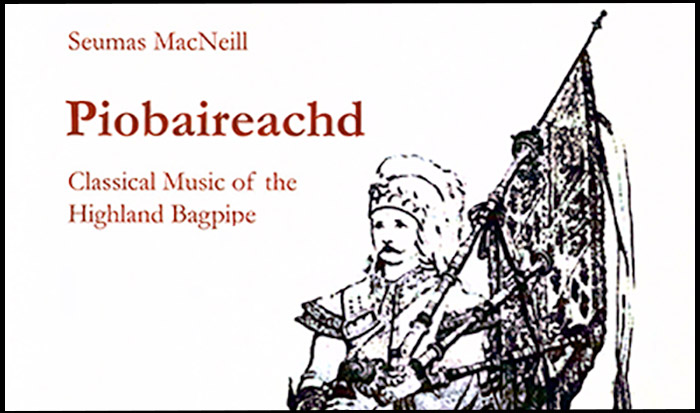
By Robert Wallace
A new edition of Seumas MacNeill’s seminal work ‘Piobaireachd – Classical Music of the Highland Bagpipe’ has been published by the Piobaireachd Society.
The book first appeared in 1968 to accompany a radio series presented by Seumas, original publisher and copyright holder, the BBC. Out of print, permission to re-issue has been granted to the Society. Seumas was, for 30 years plus, its Hon. Secretary.
In summing up the book I can do no better than re-iterate my Introduction to the new volume: ‘Seumas MacNeill produced this important work in 1968. It accompanied a radio series on ceòl mòr he was doing for the BBC. As an introduction to the great music it strikes just the right balance, satisfying the needs of the tyro and the demands of the experienced player looking for more insight.
‘For the time it was novel in its approach to pipe music notation. Here for example we have the writer breaking with convention and using multiple time signatures, the better to show correct timing. Here too we find the use of double dots and demi-semiquavers (32nd notes) as notes, again a more accurate way of representing what pipers actually play.
‘Seumas MacNeill used his professional knowledge as a senior lecturer of physics to give a thorough analysis of the bagpipe scale, and his chapters on tune classification and phrase patterns are lucidly set out.
‘This edition has been re-printed as per the original save a few necessary typographical, musical, and historical edits. Notwithstanding the fine tuning, this treatise remains as first issued in 1968, and the Society is grateful to the BBC for permission to place it once more in the public domain.’
That does not, of course, tell the full story. The Foreword by General Frank Richardson is followed by a chapter, the ‘History of the Bagpipe’, where the author touches on the precarious position the instrument found itself in not much more than 150 years ago: ‘….During the nineteenth century, and even part of the twentieth, it was looked on, by many people, as the instrument of a barbaric culture which had somehow managed to survive into modem times.
‘It was in fact an instrument which had not been slowly exposed to changing trends and fashions, but had suddenly been placed in juxtaposition with an entirely different concept of music. Either it would be rejected completely, or it would find for itself a separate niche and continue to exist in isolation as it had done in the past. This latter, of course, is what happened…..’
The quality of the prose is unsurpassed in piping literature: ‘To define a piobaireachd briefly would be impossible, because it is so different from anything else. There are no simple analogies or examples for comparison. It consists of a theme with variations, but that is as good a description as it would be to say that a Shakespeare play is a collection of speeches divided into five acts.
‘In order to understand and enjoy piobaireachd it is essential first of all to understand something of the unique characteristics of the instrument itself. The emotional reaction to the bagpipe is so intense that a reasoned appreciation of what is happening is necessary lest the performance be obscured by the means of performing…’
We then have a tour de force description of the instrument itself and the acoustic analysis mentioned in my Introduction. A journalist acquaintance of mine was a student at Seumas’s lectures in Glasgow University and attests to his skill at simple delivery of complex fact and theory. That skill is evident in this chapter.
We read on: ‘The problem of loudness itself, as distinct from unvarying intensity, is often quoted as a deterrent to those who might otherwise wish to enjoy pipe music. Here one must accept the fact that loudness is a necessary characteristic, that the great Highland bagpipe is an instrument of the open air, and that any attempt to tone it down would be just one of these modifications which led to the extinction of other bagpipes.
‘At the same time it should be noted that the full orchestra, or even a single piano, can be, and often is, played – indoors – more loudly than the bagpipe……’
I won’t emburden this review with additional detail, suffice to say there are further chapters on piobaireachd history and the great families, notation and classification of ceòl mòr, all concluding with an interesting view of what might happen in piping in the future – from a 1968 perspective.
There are thousands of pipers in the world who do not play piobaireachd. They see it as some sort of inscrutable slow air thingy unworthy of their attention. Well this book will quickly disabuse them of that.
Even if you never want to play the stuff you should at least, as a piper, know something about the music, its history, its origins, its structure. For £10 this little gem of a book will amply fill that gap in your knowledge.
- ‘Piobaireachd – Classical Music of the Highland Bagpipe’, 2020 edition, is published by the Piobaireachd Society. Size: A5; 70 pages. The book is available from the Society web shop here, and all good Highland supplies outlets. This edition is dedicated to memory of Alasdair Milne, former Director General of the BBC and Controller of BBC Scotland and a man who did much to promote the bagpipe and its music on the national airwaves.
-
Donald MacLeod Tunes – ‘Play Along’ LessonsPrice range: £2.00 through £2.50
-
MacCrimmon Piobaireachd, the Classic Tunes£2.50
-
Online Ads – Something to Sell? Looking to Buy?Price range: £25.00 through £30.00